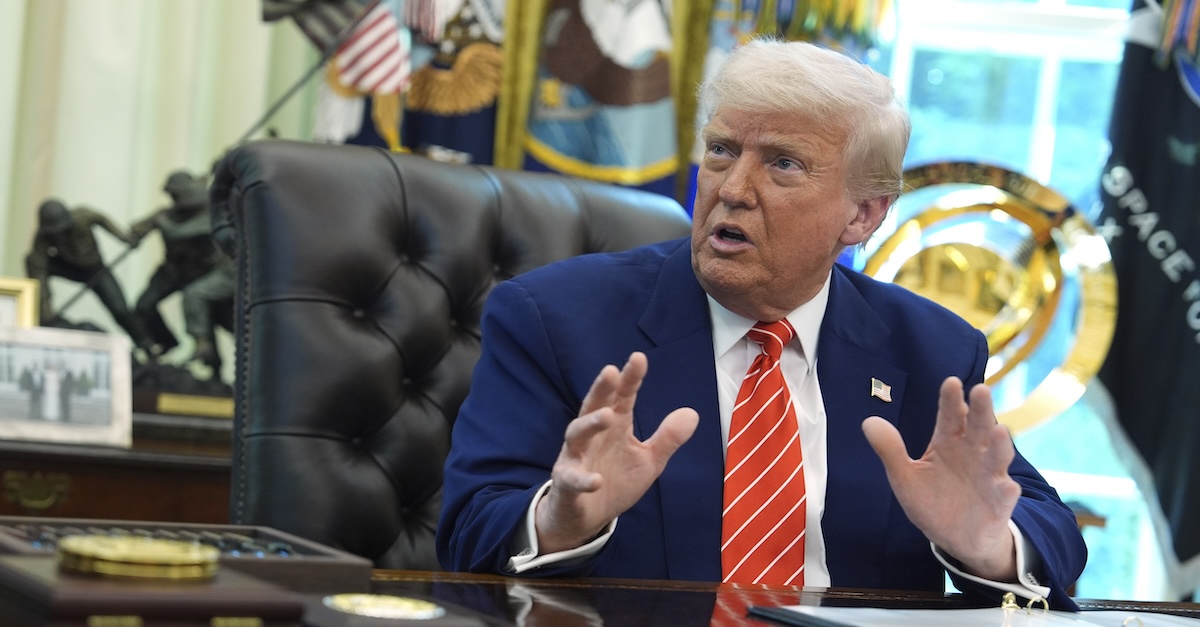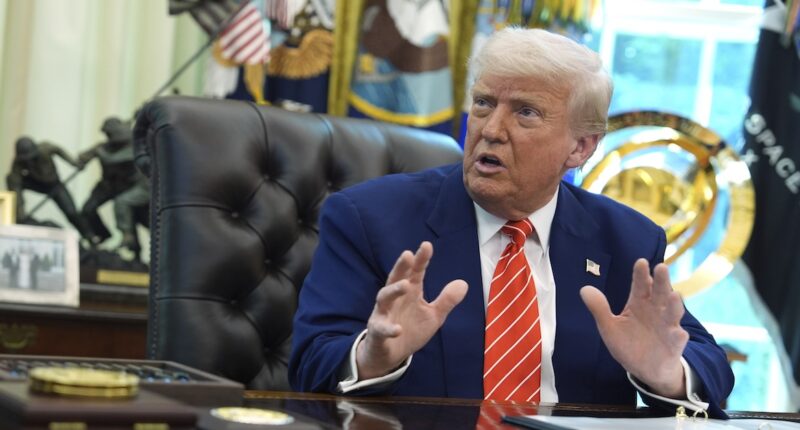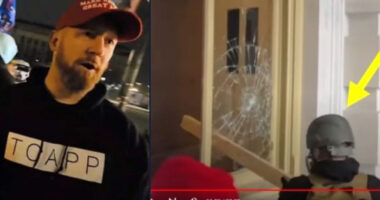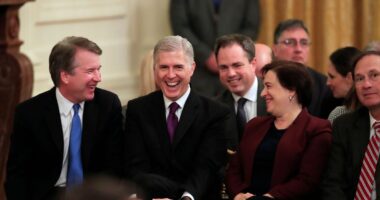
President Donald Trump speaks during a news conference with Elon Musk in the Oval Office of the White House, Friday, May 30, 2025, in Washington (AP Photo/Evan Vucci).
The Trump administration on Tuesday sought permission from an appellate court to remove three members of the Consumer Product Safety Commission (CPSC) who were reinstated during the Biden era.
In a 95-page filing submitted to the Court of Appeals for the Fourth Circuit, the U.S. Department of Justice urged for urgent action in the form of an immediate administrative stay. They also requested a broader stay to halt the summary judgment ruling and order issued by a Maryland district court the previous week.
The crux of the lawsuit is a dispute over whether President Donald Trump, by way of individuals “purporting to speak” on his behalf, had the authority to fire the trio, as the government did in early May.
The plaintiffs – Mary Boyle, Alexander Hoehn-Saric, and Richard Trumka Jr. – claim their firings, and subsequent efforts to fire their staffers, are unlawful and in violation of the Consumer Product Safety Act (CPSA), the originating statute that created the CPSC. The statute says CPSC members can only be removed by the president “for neglect of duty or malfeasance in office but for no other cause.”
Love true crime? Sign up for our newsletter, The Law&Crime Docket, to get the latest real-life crime stories delivered right to your inbox.
The government argues, in the present case and others like it, that such so-called “for-cause” removal language is unconstitutional.
“The President “as a general matter’ has ‘authority to remove those who assist him in carrying out his duties,'” the appeal reads.
And here, as in those similar cases, a great deal of legal analysis is focused on a 1935 U.S. Supreme Court case about the limitations on the president’s ability to fire appointed officials at will.
The case in question, Humphrey’s Executor v. U.S., stands for the idea that Congress intended to keep “quasi judicial and quasi legislative” agencies largely insulated from the whims of the president. Readers may recall how this case has been cited by various courts after Trump fired members of the Merit Systems Protection Board (MSPB), Office of Special Counsel, and National Labor Relations Board (NLRB).
The latest government effort is no exception.
From the emergency stay request, at length:
The Supreme Court in Humphrey’s Executor v. United States, recognized a limited exception to that rule of at-will Presidential removal for “a multimember body of experts, balanced along partisan lines, that performed legislative and judicial functions and was said not to exercise any executive power.” This exception, however, does not encompass the CPSC, which plainly exercises significant executive power when it: promulgates legislative rules that are binding on regulated entities; bans hazardous products from the marketplace, adjudicates violations of federal law, files enforcement suit in federal court with its own attorneys, or seeks millions of dollars in civil penalties. Because the CPSC does not fit within the narrow Humphrey’s Executor exception, Congress cannot restrict the President’s removal authority.
In other words, the Trump administration believes the oft-cited Supreme Court case is on their side, at best, or not relevant, at worst.
But here’s the rub: the plaintiffs in each instance – as well as every reviewing court to actually deal with the merits issues – have said this exact same case is the reason Trump cannot fire the political appointees who have sued to get their jobs back.
In his 31-page memorandum opinion, U.S. District Judge Matthew J. Maddox, a Joe Biden appointee, enjoined the government from giving the terminations effect, granted the plaintiffs access to agency resources, and ordered the government to provide back-pay and benefits to the plaintiffs and their staff. The judge said he was “agreeing with several other courts that statutory tenure protection for CPSC Commissioners is constitutionally justified by the Humphrey’s Executor exception to the President’s removal power.”
“The relief plaintiffs obtained — an order reinstating three principal officers the President has chosen to remove from office — is extraordinary and virtually unheard of,” the emergency appeal motion goes on. “Such an order would greatly impede the President’s authority to exercise ‘all of’ ‘the executive Power’ of the United States. Allowing plaintiffs to exercise executive power over the President’s objection unquestionably inflicts irreparable harm on both the Executive and the separation of powers.”
The government goes on to cite the immediate aftermath of the court’s ruling – noting that Trumka led the newly-reconstituted Democratic Party majority on the commission to try and pass a motion declaring “all CPSC actions taken while plaintiffs were removed to be ‘null, void, and of no effect,’ unless otherwise specified.”
The government goes on to mention increasing strife among the CPSC ranks, describing an entire meeting called by Trumka, which the GOP-appointed members of the commission effectively boycotted.
“This purported meeting epitomizes the chaos that has and will continue to ensue during the course of litigation where the final verdict on whether plaintiffs were unlawfully removed has not yet been rendered on appeal,” the motion reads.
Those actions, the DOJ says, are another reason the appeals court should stay the district court’s order, in line with a Supreme Court ruling that stayed the rulings in two other cases involving the MSPB and NLRB.
In that case, the justices did not rule on the merits but paused district court-ordered reinstatements while they dealt with the merits in order to “avoid the disruptive effect of the repeated removal and reinstatement of officers during the pendency of this litigation.”
The motion cites those prior stays approvingly – and demonstratively – urging the appeals court to follow the high court’s example:
The Supreme Court’s well-founded concern applies with acute force here. After the district court reinstated plaintiffs, they immediately sought not just to resume their duties, but to reverse all actions taken in the last month by the remaining CPSC Commissioners. That includes withdrawing proposed rules, firing staff, halting procedures already in place, and generally frustrating the agency’s attempts to comply with Executive Orders. That is precisely the kind of disruption and interference with the President’s constitutional authority that warrants an immediate administrative stay and a stay of the judgment pending appeal.














